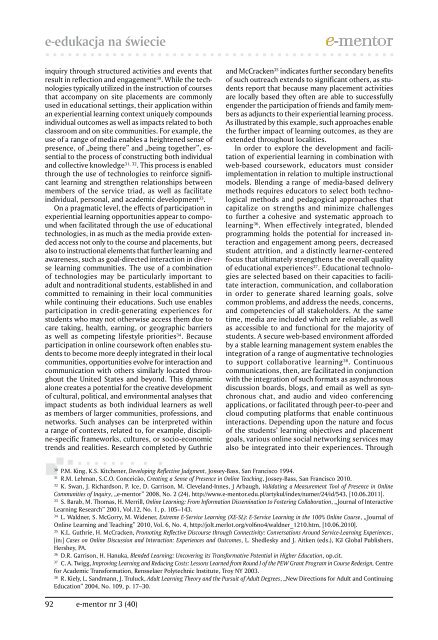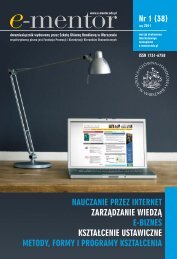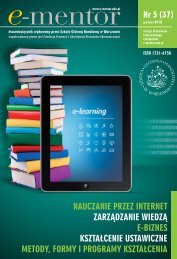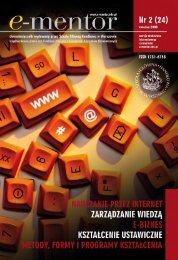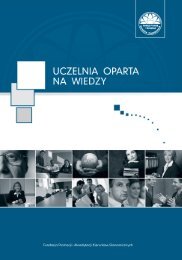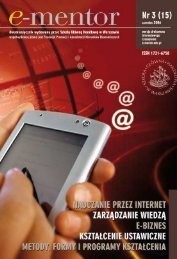metody, formy i programy ksztaÅcenia - E-mentor
metody, formy i programy ksztaÅcenia - E-mentor
metody, formy i programy ksztaÅcenia - E-mentor
You also want an ePaper? Increase the reach of your titles
YUMPU automatically turns print PDFs into web optimized ePapers that Google loves.
e-edukacja na świecieinquiry through structured activities and events thatresult in reflection and engagement 30 . While the technologiestypically utilized in the instruction of coursesthat accompany on site placements are commonlyused in educational settings, their application withinan experiential learning context uniquely compoundsindividual outcomes as well as impacts related to bothclassroom and on site communities. For example, theuse of a range of media enables a heightened sense ofpresence, of „being there” and „being together”, essentialto the process of constructing both individualand collective knowledge 31, 32 . This process is enabledthrough the use of technologies to reinforce significantlearning and strengthen relationships betweenmembers of the service triad, as well as facilitateindividual, personal, and academic development 33 .On a pragmatic level, the effects of participation inexperiential learning opportunities appear to compoundwhen facilitated through the use of educationaltechnologies, in as much as the media provide extendedaccess not only to the course and placements, butalso to instructional elements that further learning andawareness, such as goal-directed interaction in diverselearning communities. The use of a combinationof technologies may be particularly important toadult and nontraditional students, established in andcommitted to remaining in their local communitieswhile continuing their educations. Such use enablesparticipation in credit-generating experiences forstudents who may not otherwise access them due tocare taking, health, earning, or geographic barriersas well as competing lifestyle priorities 34 . Becauseparticipation in online coursework often enables studentsto become more deeply integrated in their localcommunities, opportunities evolve for interaction andcommunication with others similarly located throughoutthe United States and beyond. This dynamicalone creates a potential for the creative developmentof cultural, political, and environmental analyses thatimpact students as both individual learners as wellas members of larger communities, professions, andnetworks. Such analyses can be interpreted withina range of contexts, related to, for example, discipline-specificframeworks, cultures, or socio-economictrends and realities. Research completed by Guthrieand McCracken 35 indicates further secondary benefitsof such outreach extends to significant others, as studentsreport that because many placement activitiesare locally based they often are able to successfullyengender the participation of friends and family membersas adjuncts to their experiential learning process.As illustrated by this example, such approaches enablethe further impact of learning outcomes, as they areextended throughout localities.In order to explore the development and facilitationof experiential learning in combination withweb-based coursework, educators must considerimplementation in relation to multiple instructionalmodels. Blending a range of media-based deliverymethods requires educators to select both technologicalmethods and pedagogical approaches thatcapitalize on strengths and minimize challengesto further a cohesive and systematic approach tolearning 36 . When effectively integrated, blendedprogramming holds the potential for increased interactionand engagement among peers, decreasedstudent attrition, and a distinctly learner-centeredfocus that ultimately strengthens the overall qualityof educational experiences 37 . Educational technologiesare selected based on their capacities to facilitateinteraction, communication, and collaborationin order to generate shared learning goals, solvecommon problems, and address the needs, concerns,and competencies of all stakeholders. At the sametime, media are included which are reliable, as wellas accessible to and functional for the majority ofstudents. A secure web-based environment affordedby a stable learning management system enables theintegration of a range of augmentative technologiesto support collaborative learning 38 . Continuouscommunications, then, are facilitated in conjunctionwith the integration of such formats as asynchronousdiscussion boards, blogs, and email as well as synchronouschat, and audio and video conferencingapplications, or facilitated through peer-to-peer andcloud computing platforms that enable continuousinteractions. Depending upon the nature and focusof the students’ learning objectives and placementgoals, various online social networking services mayalso be integrated into their experiences. Through30P.M. King, K.S. Kitchener, Developing Reflective Judgment, Jossey-Bass, San Francisco 1994.31R.M. Lehman, S.C.O. Conceicão, Creating a Sense of Presence in Online Teaching, Jossey-Bass, San Francisco 2010.32K. Swan, J. Richardson, P. Ice, D. Garrison, M. Cleveland-Innes, J Arbaugh, Validating a Measurement Tool of Presence in OnlineCommunities of Inquiry, „e-<strong>mentor</strong>” 2008, No. 2 (24), http://www.e-<strong>mentor</strong>.edu.pl/artykul/index/numer/24/id/543, [10.06.2011].33S. Barab, M. Thomas, H. Merrill, Online Learning: From Information Dissemination to Fostering Collaboration, „Journal of InteractiveLearning Research” 2001, Vol.12, No. 1, p. 105–143.34L. Waldner, S. McGorry, M. Widener, Extreme E-Service Learning (XE-SL): E-Service Learning in the 100% Online Course, „Journal ofOnline Learning and Teaching” 2010, Vol. 6, No. 4, http://jolt.merlot.org/vol6no4/waldner_1210.htm, [10.06.2010].35K.L. Guthrie, H. McCracken, Promoting Reflective Discourse through Connectivity: Conversations Around Service-Learning Experiences,[in:] Cases on Online Discussion and Interaction: Experiences and Outcomes, L. Shedlesky and J. Aitken (eds.), IGI Global Publishers,Hershey, PA.36D.R. Garrison, H. Hanuka, Blended Learning: Uncovering its Transformative Potential in Higher Education, op.cit.37C. A. Twigg, Improving Learning and Reducing Costs: Lessons Learned from Round I of the PEW Grant Program in Course Redesign, Centrefor Academic Transformation, Rensselaer Polytechnic Institute, Troy NY 2003.38R. Kiely, L. Sandmann, J. Truluck, Adult Learning Theory and the Pursuit of Adult Degrees, „New Directions for Adult and ContinuingEducation” 2004, No. 109, p. 17–30.92 e-<strong>mentor</strong> nr 3 (40)


